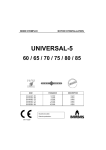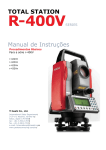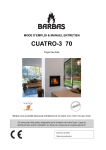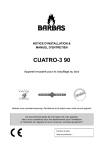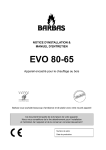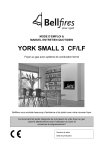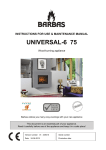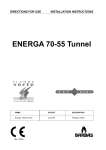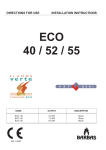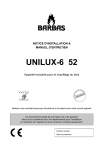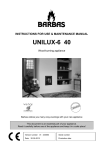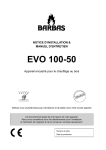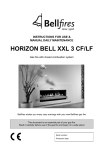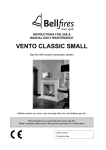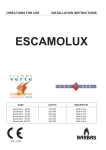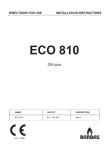Download Manual - Interfocos
Transcript
DIRECTIONS FOR USE INSTALLATION INSTRUCTIONS UNIVERSAL-5 60 / 65 / 70 / 75 / 80 / 85 NAME Universal-5 Universal-5 Universal-5 Universal-5 Universal-5 Universal-5 60 65 70 75 80 85 Serial number: Production date: EN -13229 OUTPUT DESCRIPTION 6.0 kW 7.0 kW 8.0 kW 9.0 kW 10.0 kW 10.0 kW Fireplace insert Fireplace insert Fireplace insert Fireplace insert Fireplace insert Fireplace insert UNIVERSAL-5 60 / 65 / 70 / 75 / 80 / 85 TABLE OF CONTENTS Page 1. Introduction 1.1 Preface............................................................................ 1.2 Safety.............................................................................. 5 5 2. Location.................................................................................. 7 3. Installation instructions............................................................ 10 4. Operation of the fireplace insert.............................................. 20 5. Stoking up for the first time..................................................... 21 6. Use 6.1 6.2 6.3 6.4 6.5 Ventilation....................................................................... Getting the fire going...................................................... While stoking.................................................................. Heating economically...................................................... Cleaning the window....................................................... 22 22 23 25 25 General hints 7.1 Tips................................................................................. 7.2 Output............................................................................. 26 27 8. Fuel......................................................................................... 29 9. Amount of fuel......................................................................... 30 10. Regular maintenance.............................................................. 31 11. Replacement parts.................................................................. 32 12. Dimensions............................................................................. 40 13. Technical data......................................................................... 42 14. Frequently asked questions.................................................... 44 15. Warranty terms....................................................................... 48 7. 3 UNIVERSAL-5 60 / 65 / 70 / 75 / 80 / 85 4 UNIVERSAL-5 60 / 65 / 70 / 75 / 80 / 85 1 INTRODUCTION 1.1 PREFACE We would like to congratulate you on your purchase of this modern BARBAS fireplace insert. This quality product will give you years of heating pleasure as you enjoy the play of the flames and the cosy glow of the fire. This manual contains directions for both positioning the appliance and for its environmentally-friendly use. It also contains technical data for the appliance, parts information and directions in the event of problems. Study this manual carefully before using the fireplace insert. We recommend you keep this manual in a safe place for reference purposes. 1.2 SAFETY AND INSTALLATION INSTRUCTIONS Safety • Do not place flammable objects within 100 cm of the appliance. Pay special attention to furnishings and ornaments around the fire. • When you use your fireplace insert, the exterior will become hot. Always wear the glove or use the accessories supplied when filling etc. Protect yourself and others (especially children!) from burns. Do not leave children unattended when the fire is burning. • Watch your clothing. Synthetic clothing in particular can easily catch fire and burn intensely. • Do not approach the appliance with flammable materials or liquids. Any work with solvents, adhesives etc. in the space heated by the fireplace insert can be very dangerous. • Make sure you know what state your chimney is in. Cracks in the chimney may not only lead to damp, staining of walls and leaking of smoke, they can also impair the carrying off of smoke. Make sure you get proper advice from your Barbas dealer or other specialist company. • Avoid chimney fires! Have your chimney swept at least once per year more often if you use your fire a lot. Prevent excessive deposits of soot inside the chimney by not burning freshly-cut wood. Instead, burn clean, dry chopped wood. 5 UNIVERSAL-5 60 / 65 / 70 / 75 / 80 / 85 • Do not use your stove as a barbecue. This can cause (flammable) fat deposits to be left in the chimney and hastens the chimney becoming clogged. Prevent your chimney being soiled from above (birds’ nests etc.) by fitting a suitable cap to the chimney pot. • Follow the instructions issued by your local fire brigade. The stove can be taken in operation if national and local regulations are satisfied. The required constructive adaptations should be satisfied as well. Installation instructions 6 • Wood and wood briquettes may be stoked in the stove. Coals can’t be burned in the fire. • Never use the heater to burn rubbish. • Please read all instructions / stickers on and around the appliance. • Please also study the directions for use before using the appliance for the first time. When you first fire up your appliance, there are a number of extra points you should take into account. See section 5. • In transit, some parts of the appliance may have moved from their original place. Check that the door opens and closes, the brake plate is fitted correctly to the brackets at the top of the fire, the internal panels are fixed to the walls and the plates on the bottom have not moved. Check whether the grate is lying correctly and there are no foreign objects in the ashtray. • Avoid over-loading (white burning glow), caused, for example, by lengthy burning with primary air (combustion air supply slider all the way to “ + ”) or by burning too much wood in one go. The fire can then become over-heated. This may damage the cast iron grate and the metal flue gas flap. • The appliance may only be set up if the appliance and location meets the - national and local installation regulations; - local fire brigade regulations and required architectural provisions. UNIVERSAL-5 60 / 65 / 70 / 75 / 80 / 85 2 LOCATION 2.1 INCLUDED Documentation Warranty Manual Attributes Glove Operating hook / Poker N.B. If any part is missing, please contact your dealer. 2.2 PREPARATION FOR POSITIONING Check all functions of the fireplace before fitting. • Check the opening and closing operation of the door. Turn the handle all the way down: Door is locked. This handle position should be set when the appliance is not in use. Handle 30° forwards: Door is still fully locked. This handle position should be used when the appliance is being stoked. It allows the door to be opened and closed easily. 7 UNIVERSAL-5 60 / 65 / 70 / 75 / 80 / 85 Handle ± 50° forwards: The door releases from its lock and be opened forwards. • Check the operation and setting of the flue gas flap. Flue gas flap pin Flue gas flap Door open Door closed 8 Pin comes forwards Pin is pressed in by the door Flue gas flap open Flue gas flap closed UNIVERSAL-5 60 / 65 / 70 / 75 / 80 / 85 • Check the operation of the slider for controlling the combustion air. • Check whether the ashtray is completely empty. • Report any defects immediately to your dealer. • Remove enclosed documents and components from the fire. • Fit the fan-set (optional). Have the suitability of the area in which the fire is to be fitted (and the chimney) approved by a specialist. The space into which the fire is to be fitted must in no way be damaged. The fire must have its own chimney, constructed in compliance with current legislation. 9 UNIVERSAL-5 60 / 65 / 70 / 75 / 80 / 85 3 INSTALLATION INSTRUCTIONS 3.1 FITTING THE FIREPLACE When fitting one of these fireplace inserts local and/or national regulations relating to fire safety must be followed. In case of doubt, consult the fire safety department of the local fire brigade, particularly if the fire is to be fitted in a home with walls and/or floors containing flammable material. The connection of several appliances to a single flue/chimney is not allowed. 3.2 CHIMNEY If no chimney is immediately available, have one fitted by a recognised specialist only. The chimney must be compliant with local regulations and is particularly important because it has a significant bearing on the function of the appliance. Basic rules: • A chimney for an open fire is not, by definition, suitable for a closable model (i.e. an appliance with doors). As a closed appliance draws in much less (cold) air, the smoke is hotter. Please have your chimney inspected to see whether it is suitable for a closable appliance. • The chimney opening must be at least 5 metres above the top of the door opening of your appliance. • The chimney must protrude at least 40 cm above the apex of a sloping roof and at least 1 metre above a flat roof. In short, the chimney must always end in an area with a negative air pressure. Contact your local chimney sweep for the exact dimensions of the chimney opening. • The internal diameter must not be less than that of the appliance at any point (even at the end of the pipe). • Avoid bends at all costs. The maximum deviation from the perpendicular is 45°. • Both the dimensions and the construction must meet stringent construction standards. Your recognised specialist will be pleased to assist. • Contact your fire insurer to make sure that your policy is in order. 10 UNIVERSAL-5 60 / 65 / 70 / 75 / 80 / 85 3.3 FITTING A fireplace insert can be fitted in the newly-built or existing chimney breast of an open fire. When fitting, both fire safety and operational safety must be safeguarded. The fitter is responsible for this. General guidelines: • If there is a wooden beam above the fitting location, heat must not radiate directly onto it. An insulation plate must be hung below the beam, leaving an air gap between it and the beam of at least 1 cm. • Always use (white) unbound ceramic insulation wool. Bound material (yellow), such as glass and rock wool, spreads an irritating smell on heating, causes excess smoke and is unsuitable for high temperatures (insulation requirements: temperature ≥ 700°C, density 80 kg/m3). • If electrical connections are to be fitted for an extractor fan, have this done by an expert. • Before fitting, remove the door to protect the glass. 3.3.1 Aeration / ventilation A fireplace insert generates : - heating air - combustion air Heating air (convection air) is devoted to the convection of heat from the appliance to the room. No other provisions are necessary. The source of heat is in the room and stays there. Combustion air is needed to keep the combustion going by drawing in air from the room due to the natural draught of the chimney. The intake opening for the air is under the door. When using the appliance, please ensure there is a sufficient supply of fresh air: minimum 150 cm2 opening in the room where the fire is placed. Make sure that the ventilation supply is open; this is particularly important with today’s airtight dwellings. If the dwelling has mechanical ventilation that creates under pressure in the room where the appliance is located, it is necessary to fit a flue gas fan. The type of flue gas fan is dependent on the capacity of the mechanical ventilation system. Always consult your fitter about this. 11 UNIVERSAL-5 60 / 65 / 70 / 75 / 80 / 85 In dwellings with an operating extractor hood, this should be turned to the lowest setting or turned off altogether. If the extractor hood remains in use, additional ventilation must be provided in compensation. This will not only avoid poor combustion, but will also prevent flue gases being sucked from the appliance into the room. Should creating an extra ventilation opening prove insufficient, it is then necessary to fit a flue gas fan. 3.3.2 Fitting in an existing chimney breast • Remove the existing fire basket or stoking stones and remove the shut-off flap. The chimney must be intact and must not be damaged during fitting. The chimney breast opening must be big enough for a gap of 1 - 3 cm to be left all round the appliance. Clad the chimney breast opening from the inside with a ceramic wool fireblanket or similar (see section 3.3). • Extend the existing chimney so that it ends at the appliance’s smoke outlet. To do this, use a flexible, double-walled stainless steel chimney, for example. • Slide the appliance into the chimney breast opening. Seal the smoke outlet where it joins the chimney so that no soot can accumulate above the appliance under any circumstances. • Level off the appliance so that the cover does not catch on the base. • Fill any gaps around the appliance with a ceramic insulation wool fireblanket and position the frame (where supplied) • Close the existing convection openings at the top side of the appliance. 12 UNIVERSAL-5 60 / 65 / 70 / 75 / 80 / 85 3.3.3 Fitting in a newly-built chimney breast • If required, a convection set can be added when installing the appliance. • Use convection set: The function of the convection set (option) is to improve the convection through the appliance, resulting in efficiency improvement and preventing high temperatures in the chimney breast. The set consists of: • 3 m aluflex • 2 exit grids (white) • 2 collar adaptors Ø125 mm • 4 locking bands • Assembly convection set: ° Secure the 2 collar adaptors to the appliance. 13 UNIVERSAL-5 60 / 65 / 70 / 75 / 80 / 85 ° ° ° ° Now connect the flexible hoses to the 2 collar adaptors (Ø125 mm) on the top of the fire and to the metal fitting box on the air exit grids that are being used (do not forget to fit hose clamps). Ensure that the flexible hose connections are gastight. The air exit grids cannot be fitted until a few days later, once the masonry has been pointed and allowed to dry. If one or more channels are connected leading to other rooms, these rooms must be fitted with closable grids. These are available from your dealer, as well as the flexible hoses and clamps required. Within a range of 30 cm either side and 50 cm above the escape opening (exit grids), there must be no flammable materials (e.g. wooden ceiling, fitted furniture). • Clad the appliance on the top, sides and rear up to the front edge with an approx. 10 cm thick ceramic isolation wool fireblanket. Leave a few centimetres clearance between the front of the chimney breast and the appliance. • Level off the appliance. Check that the slides do not catch on the base. • Make a good seal between the smoke outlet from the appliance to the chimney. See also 3.3.4. Ensure that the entire flue is gas-tight. • Ventilate the chimney, by placing ventilation openings at the top and bottom of the chimney breast. 14 UNIVERSAL-5 60 / 65 / 70 / 75 / 80 / 85 Figure 1: Use of convection set and ventilation of fireplace • Close up the front (the appliance has its own inlets for convection air). Available BARBAS grids (option) for ventilating the fireplace: COLOUR DIMENSION (cm) CLEAR OPENING (cm2) Brass or white (incl. fitting) 13.5 x 13.5 75 Brass or white (incl. fitting) 27.0 x 13.5 150 Perma Air (white) 43.0 x 22.0 550 15 UNIVERSAL-5 60 / 65 / 70 / 75 / 80 / 85 • If the fire is to be placed against a bearing wall or against a wall containing flammable material, an air gap of at least 20 mm should first be created. Before it a false wall, 100 mm thick, must be built of masonry or aerated concrete. • If the fire is not placed against a bearing wall or a wall containing flammable material, no false wall is necessary. Layers of insulation of at least 100-mm thickness will then be sufficient (class A1, DIN 4102-compliant). See also section 3.3. • After four weeks, your fire will be ready for use. 3.3.4 Connecting the smoke outlet The appliance comes with a detachable smoke outlet connection; Universal-5 60/65: Ø150 mm (Ø148 mm external), Universal-5 70/75/80/85: Ø180 mm (Ø178 mm external). This connection is intended for steel stovepipes, double/single-skinned stainless steel (insulated) flues or double/single-skinned flexible stainless steel flues. After the appliance has been installed, it can be connected to the flue. In order to be able to disassemble the smoke outlet connection, remove the flue gas flap and the brake plate first. See section 11 for the disassembly sequence: “Sequence for replacing the interior of the appliance”. 16 UNIVERSAL-5 60 / 65 / 70 / 75 / 80 / 85 • Disassembling the smoke outlet connection. • Pull the stovepipe or the stainless steel (flexible) pipe downwards through the appliance and secure it to the smoke outlet connection. Stainless steel flexible 17 UNIVERSAL-5 60 / 65 / 70 / 75 / 80 / 85 Fix with hose clamp (Minimum 2 pieces per connection.) Stovepipe of steel 18 UNIVERSAL-5 60 / 65 / 70 / 75 / 80 / 85 • Push the smoke outlet connection back upwards and secure it in place. • Replace the brake plate and flue gas flap. 3.4 HEAT TRANSFER WITH BUILT-IN FANS The heat transfer can be amplified by transporting the heat with fans. With this system, hot air is blown into the room. The fans only cut in at the point that the fire is up to temperature (> 40°C). The 42 V fans are protected against overheating. 19 UNIVERSAL-5 60 / 65 / 70 / 75 / 80 / 85 4 OPERATION OF THE FIREPLACE INSERT Figure 2: Operation 1 2 3 4 5 6 7 8 9 10 11 12 13 20 Handle Ceramic heat-proof glass Locking slider for operating pin of flue gas flap Operating pin of flue gas flap Smoke outlet (can be dismounted) Convection air escape opening Internal panels (vermiculite plate) / Inner lining Grate (cast-iron) Ashtray Wood rack Combustion air-supply slider (Combined operation for the primary and secondary combustion air-supply) Temperature switch holder Convection air-supply (installation of 42 VAC convection-fans: option) UNIVERSAL-5 60 / 65 / 70 / 75 / 80 / 85 5 STOKING UP FOR THE FIRST TIME If you have had your chimney breast modified or newly built, first allow your home to dry properly. Walls which have not been allowed to dry properly are a magnet for dust such as any smoke particles created when stoking up the fireplace insert or suddenly opening the door. Even scorched dust can easily be retained by damp walls. Think also of dust on the outside of the appliance or on hot radiators etc. Check that all packaging, stickers etc. and/or all dust and waste has been cleaned up after the installation work (to avoid it getting scorched/causing a bad smell). Check again that all moving parts are in order and that loose parts such as the brake plate, flue gas flap, internal panels, grate etc. are in the correct position. They may have moved during installation. The fireplace insert has a heat-proof finish. It only hardens at high temperatures. When unpacked, it is therefore not fully hardened. It can easily be damaged at this time. Begin stoking up the fireplace insert with a low flame (see section 6). Increase the heat gradually for approx. 2 hours until you reach the correct output. Keep it at this level for another 2 - 3 hours. The finish will now be properly hardened and can be touched without damaging. The hardening process creates a nasty, though harmless, smell/vapour. Adequate ventilation is of the utmost importance. 21 UNIVERSAL-5 60 / 65 / 70 / 75 / 80 / 85 6 USE 6.1 VENTILATION Air is a vital component of the combustion process. Ensure that there is a sufficient supply of fresh air. For each kilo of wood that you put on the fire (door closed), 10 - 15 m3 of extra air is needed. That means 50 m3 per hour! As you can see, a plentiful supply of air is essential. 6.2 GETTING THE FIRE GOING (Figure 2) When you start the fire, the chimney is still cold and there is little draught. This means that the chimney’s capacity to draw in air is limited. That is why the air supply has to be assisted by opening the locking slider (and/or the door) and air supply slider. Use dry, fine wood and some scrunched-up paper or firelighters to start the fire. open close Locking slider for operating pin of flue gas flap (inside of door). Locking slider all the way to the right (closed): Flue gas flap operation works normally: Door open Pin comes forwards Door closed Pin is pressed in by the door Locking slider all the way to the left (open): Flue gas flap always remains fully open !! 22 Flue gas flap open Flue gas flap closed UNIVERSAL-5 60 / 65 / 70 / 75 / 80 / 85 When setting the fire, move the locking slider all the way to the left. If necessary, leave the door ajar for 10 minutes. Do not open the door wide, as the window will remain cold. If the door is shut during this time, smoke will condense on the glass and form soot. Move the air supply slider all the way to the right “ + ” only when starting the fire. Prevent white glow and over-firing. 6.3 INSTRUCTIONS WHILE STOKING After approx. 10 minutes, the fire will be burning fiercely. You can now top it up with a few larger blocks of wood. Move the locking slide all the way to the right when the blocks are burning well and close the door. Using the air supply slider you can now adjust the air supply for further combustion. Make sure the fire burns quietly. Note: Once you have got the fire going, leave the air supply slider in the centre position for optimal combustion. Your fire will then be much cleaner and more efficient (more heat, less topping up). Control range of primary air supply (by grate) Control range of secondary and tertiary air supply Combustion air supply slider Centre position 23 UNIVERSAL-5 60 / 65 / 70 / 75 / 80 / 85 We recommend that you maintain a substantial layer of ash (2 - 3 cm). This not only forms a protective layer for the base of the appliance but also significantly reduces consumption of fuel and allows new wood to catch light easier. When loading the fire with fuel, two blocks measuring 30 cm long and 30 cm in diameter is sufficient. Do not add more fuel until the previous fuel has burned down to the charcoal stage. The flames are then almost no longer visible. Do not leave the door open longer than necessary. Weather conditions In order to reduce pollution and any other inconvenience, we advise not firing up the fire when there is no wind, or in foggy/misty conditions. Smoke development Your fire has been designed to be used with the load/observation door closed. Should you use it with the door open, under certain circumstances (presence of mechanical ventilation, draught, differences in barometric pressure) smoke may enter the room in which the fire is situated. Use of the fire Your fire is suitable for periodic use. The fire may only be positioned in a place where the location, construction and activity in the room can accommodate it without danger. Ventilation When using the fire, ensure a good supply of fresh air, particularly if the combustion air is drawn from the room itself. Turn on the flue gas fan if the flue is fitted with one. Spare parts Any replacement parts must be new, original parts. Use of non-original/ reconditioned parts will invalidate your warranty. Modification Do not make modifications to your fire. Any alteration to your fire, of whatever nature, will also invalidate your warranty. 24 UNIVERSAL-5 60 / 65 / 70 / 75 / 80 / 85 Continuous stoking with the primary air supply open (combustion air supply slider is right over to the “ + “ position) (air through the grate) causes a fiercely white-hot fire that can damage the grate and other parts of the fireplace. 6.4 HEATING ECONOMICALLY The most environmentally-friendly and economic way of heating with wood is to have your fire hot but calm. The ash should appear to glow a soft red-orange and should not glow like a blacksmith’s fire. Fires like that burn quickly and intensely, leaving little time for complete combustion. Your fire is at its most economical when: • Burning with the door closed. This makes the fire hotter and improves combustion. • Using dry and clean wood (as described further in section 8). • Always ensure even combustion. Stoke with the primary air regulator closed. To do this, place the air supply slider in the centre position. • The bed of the fire should be composed of one material, though the fire must have easy access to air. Position the blocks of wood (loosely and evenly) horizontally on the bed of ash, so that they are separate and several centimetres away from the walls. 6.5 CLEANING THE WINDOW After several burning hours, a light deposit may form on the inner side of the window. Once the fire has cooled down, this deposit can be removed using glass cleaner or ceramic hob cleaner. 25 UNIVERSAL-5 60 / 65 / 70 / 75 / 80 / 85 7 GENERAL HINTS 7.1 TIPS • Burn dry wood only. Damp wood not only burns poorly, it causes more pollution in the appliance (window), the chimney, your room (when opening the door of the appliance, for instance) and the environment. Wood can only be classified as dry if it has been stored under a Dutch barn for at least two years (not covered with plastic). Never use painted or impregnated wood. The gases emitted when burning painted or impregnated wood are aggressive and will affect the appliance, the environment and your health. • Ensure that your fire burns well. The smoke generated should be translucent or white and the windows of the fire will remain clean. We recommend that you do not ‘pinch off’ your fire (by closing all air openings). Doing so will hinder combustion which, apart from polluting the atmosphere, will lead to deposits of soot and tar in your chimney (which, unchecked, will increase the risk of chimney fire). • Keep the door shut when the fire is burning. Doing so improves the performance of your fire 8 - 10 times, benefiting the environment and the heat in your home (less topping up, see section 7.2). You will also prevent fire damage from any particles the fire ‘spits’ out (this is a particular problem with softwood from conifers). If your floor contains flammable material, an extra floor plate is required. • Avoid lighting a fire in misty or still conditions. If the wind is still, there is hardly any draught in the cold chimney. As smoke is heavier than air, there is a chance that smoke will enter the room. If there is mist in the air, smoke coming out of your chimney will cool quickly and fall, causing problems in your area. • Do not extinguish your fire with water - let it burn out. The part of the inner lining that is in direct contact with the fire is clad with cast iron sections or fireresistant material. Sudden changes in temperature may lead to it deforming or cracks appearing. 26 UNIVERSAL-5 60 / 65 / 70 / 75 / 80 / 85 • 7.2 Chimney fire. If, despite all the precautions, a fire should occur in the chimney (you generally notice that because of a roaring sound in the chimney), do the following: • Immediately shut the chimney flap (if fitted). • Immediately shut the air supply to the fire. • Call the fire brigade (112). • Quickly quench the fire in the appliance with sand or soda in order to prevent smoke in your house. • Never use water to put out the fire. • Ventilate. • If there has been a fire in the chimney, have it swept and inspected for damage and leakage. OUTPUT In practice, combustion is all about loss. This entails: • Loss through excess heat leaving the chimney, rather than going into the room. • Loss through insufficient combustion, such as CO (carbon monoxide) and soot particles. • Loss through excessive unburnt fuel in the ash. The rate at which fuel can burn completely is called the output. A well-stoked fire achieves output of 75% and thus falls into the category of high-output/ low emissions fires. This means that you benefit directly by using less wood to achieve the same level of heat. The environment benefits as well: a well-stoked, high-output appliance means less pollution and fewer odours. Adverse effects on the output are: • Burning the fire with the door open. A warm chimney works in the same way as an extractor. When the door is open, the chimney draws in much more air than is necessary for combustion. This relatively cool air cools down the fire. 27 UNIVERSAL-5 60 / 65 / 70 / 75 / 80 / 85 • Excessive chimney draught. The combustion air does not reach the fuel, but leaves the appliance via the chimney. The fire cools and the combustion quality decreases. • Using too much wood. This is a problem if your fireplace insert is too small. In that case, it becomes overloaded and burns more wood than heat emitted. In this case too the fuel cannot burn completely. More to the point, there is not enough air to mix with the flames. This has an extra impact on the environment. • Admitting too much air under the fuel. (Combustion air supply slider is fully over to the “ + ” position.) Combustion is raised to high intensity (like a blacksmith’s fire). Combustion really needs time. If combustion is too intense, there is insufficient time for the fire to radiate all the heat. The chimney will become excessively hot and the same will be true of the escaping smoke. This heat is thus lost. 28 UNIVERSAL-5 60 / 65 / 70 / 75 / 80 / 85 8 FUELS 8.1 WOOD Suitable fuels are: • All sorts of clean wood (forested). The wood must have been dried for at least two years. Well-dried wood has a humidity percentage between 10 and 20%. Recommended dimensions: length = 30 cm; outline 30 cm. • Compressed wood blocks without binder (see wood dimensions). • Hard woods burn slowly and easily form charcoal; for example hornbeam, oak, ash, beech, elm and birch. Softwood burns with more flame, but forms less charcoal and radiates less heat. Examples are spruce, pine, poplar and linden. Unsuitable fuels are: • Painted, bonded (chipboard, MDF etc.) or impregnated wood, plastic and other flammable waste. Stoking a fire with this is completely forbidden. To re-iterate: the combustion gases released by these materials are aggressive and will attack your fireplace insert and the environment. • Paraffin-containing open fire lighters are not suitable for a closed fire. A closed fire generates more heat than an open fire, thus the paraffin will melt out of the blocks prematurely. • Damp wood burns poorly, is unsuitable and produces too much smoke (including in the room when you are topping up the wood), dirties the glass, leaves deposits in the chimney and delivers about half the heat output of dried wood. The Universal-5 is not suitable for coal firing. 29 UNIVERSAL-5 60 / 65 / 70 / 75 / 80 / 85 9 AMOUNT OF FUEL 9.1 AMOUNT OF FUEL Each appliance is constructed for a certain maximum amount of fuel. Remember that the more fuel you put into your fire, the hotter it will become and overheating may even occur. If this happens, there is a risk of fire. It may also damage your appliance and chimney. BARBAS will not assume liability for damage caused by overheating. If you have chosen the right appliance for your room, it will provide sufficient heat with a single layer of wood blocks (a wood block is approx. 30 cm long and 30 cm around the edges). Burning one layer of wood can lead to varying outputs. When used correctly, one load will burn in around one hour. Putting in too much wood at once can lead to the appliance being overloaded. You can best vary the capacity of your appliance with the amount of fuel. Example: The fire has an output of 10 kW and an efficiency of 75%: Wood: Briquettes: 3 blocks, each around 1 kg 5 briquettes, each around 0.5 kg Your fire has an output of 6 kW: Wood: Briquettes: 9.2 2 blocks, each around 1 kg 3 briquettes, each around 0.5 kg HEAT RADIATION The table below shows the temperatures which can theoretically be achieved by burning wood. Heat radiation Sort of fuel Dry wood (average) kWh/kg 4.3 The heating value of wood (18.7 MJ/kg at 0% humidity) is not affected by the sort of wood. What does make a difference is the relative humidity of the wood (15.6 MJ/kg at 15% humidity). 30 UNIVERSAL-5 60 / 65 / 70 / 75 / 80 / 85 10 REGULAR MAINTENANCE • Emptying the ashtray : Weekly, 48 hours after last heating • Cleaning the glass : As required • Door and ashtray seals : Check annually before heating is resumed. Replace as necessary • Sweep and inspect chimney : Annually before heating is resumed • Internal panels : Check annually * Clean internal panels, as necessary with hand brush * Replace panels as necessary • Grate : Check annually for cracks / breakage • Sliders / flaps : Check function annually • Convection channels : Clean annually • Paint : Annually, if necessary touch up with BARBAS heat-resistant paint (do not use with open fires !) • Parts • Modifications : Individual parts for replacement/ accessories are available from your BARBAS dealer Use only original parts : Introduced modifications to the appliance are not permitted 31 UNIVERSAL-5 60 / 65 / 70 / 75 / 80 / 85 REPLACEMENT PARTS 32 13 14 15 16 17 18 19 20 21 12 11 10 9 8 7 6 5 4 3 2 1 11 UNIVERSAL-5 60 / 65 / 70 / 75 / 80 / 85 UNIVERSAL-5 without frame Replacement parts Item no Description Number 1 body 1 2 smoke connection 1 3 integrated frame side strip 2 4 integrated frame top strip 1 5 cover combustion air supply slider 1 6 internal panels rear L/R (vermiculite plate) 2 7 bottomplate rear (vermiculite plate) 1 8 internal panel rear-centre (vermiculite plate) 1 9 bottomplate L/R (vermiculite plate) 2 10 ashtray 1 11 internal panels side L/R (vermiculite plate) 2 12 bottomplate front (vermiculite plate) 1 13 wood rack (vermiculite plate) 1 14 wood rack protective strip (stainless steel) 1 15 cast-iron grate 1 16 door 1 17 glass 1 18 operating pin of flue gas flap 1 19 flue gas flap 1 20 brake plate holder 1 21 brake plate (vermiculite plate) 1 When ordering, please give the serial number. 33 34 12 13 14 15 16 17 18 19 20 11 10 9 8 7 6 5 4 3 2 1 UNIVERSAL-5 60 / 65 / 70 / 75 / 80 / 85 UNIVERSAL-5 60 / 65 / 70 / 75 / 80 / 85 UNIVERSAL-5 with frame Replacement parts Item no Description Number 1 body 1 2 smoke connection 1 3 frame 1 4 cover combustion air supply slider 1 5 internal panels rear L/R (vermiculite plate) 2 6 bottomplate rear (vermiculite plate) 1 7 internal panel rear-centre (vermiculite plate) 1 8 bottomplate L/R (vermiculite plate) 2 9 ashtray 1 10 internal panels side L/R (vermiculite plate) 2 11 bottomplate front (vermiculite plate) 1 12 wood rack (vermiculite plate) 1 13 wood rack protective strip (stainless steel) 1 14 cast-iron grate 1 15 door 1 16 glass 1 17 operating pin of flue gas flap 1 18 flue gas flap 1 19 brake plate holder 1 20 brake plate (vermiculite plate) 1 When ordering, please give the serial number. 35 UNIVERSAL-5 60 / 65 / 70 / 75 / 80 / 85 Sequence for replacing the interior of the appliance: - Remove the grate and ashtray. - Remove the flue gas flap by lifting it slightly, tipping it backwards and removing it. - Remove the bottomplates. rear 36 right UNIVERSAL-5 60 / 65 / 70 / 75 / 80 / 85 left front - Remove the wood rack. - Remove the right-hand side panel. To do this, lift the brake plate slightly. 37 UNIVERSAL-5 60 / 65 / 70 / 75 / 80 / 85 - Remove the left-hand side panel. To do this, lift the brake plate slightly. - Remove the brake plate by lifting it slightly and removing it sloping to one side. - Remove the right-hand panel by sliding it slightly to the right and taking it out. 38 UNIVERSAL-5 60 / 65 / 70 / 75 / 80 / 85 - Slide the centre-rear panel a little to the right. - Remove the left-hand panel. - Remove the centre-rear panel. The entire interior is now disassembled. The interior is reassembled in the reverse order. 39 UNIVERSAL-5 60 / 65 / 70 / 75 / 80 / 85 12 DIMENSIONS 12.1 UNIVERSAL-5 (without frame) Appliance 40 B C A D E F G H I Universal-5 60 447 Ø150 594 325 174 462 269 427 495 Universal-5 65 465 Ø150 612 325 174 480 369 427 595 Universal-5 70 547 Ø180 694 325 174 562 319 427 545 Universal-5 75 565 Ø180 712 356 195 580 439 457 665 Universal-5 80 607 Ø180 754 356 192 622 369 457 595 Universal-5 85 665 Ø180 812 356 193 680 469 457 695 UNIVERSAL-5 60 / 65 / 70 / 75 / 80 / 85 12.2 UNIVERSAL-5 (with frame) Appliance A B C D E F G H I J K Universal-5 60 594 447 Ø150 325 174 462 269 427 495 684 541 Universal-5 65 612 465 Ø150 325 174 480 369 427 595 702 641 Universal-5 70 694 547 Ø180 325 174 562 319 427 545 784 591 Universal-5 75 712 565 Ø180 356 195 580 439 457 665 802 711 Universal-5 80 754 607 Ø180 356 192 622 369 457 595 844 641 Universal-5 85 812 665 Ø180 356 193 680 469 457 695 902 741 41 UNIVERSAL-5 60 / 65 / 70 / 75 / 80 / 85 13 TECHNICAL DATA UNIVERSAL-5 60 UNIVERSAL-5 65 UNIVERSAL-5 70 Combustion: Measured in compliance with EN 13229 : 2001 and EN 13229 - A2 : 2004 Fuel Nominal output Efficiency PM10 Dust emissions Flue gas mass flow Flue temperature Chimney draught Wood 6 kW 78% 12 mg/m3n 6.0 g/s 238 °C 0.12 mbar Wood 7 kW 78% 17,5 mg/m3n 7.35 g/s 231 °C 0.12 mbar Wood 8 kW 78% 23 mg/m3n 8.7 g/s 224 °C 0.12 mbar Smoke connection Ø150 mm (Ø148 mm ext.) Ø150 mm (Ø148 mm ext.) Ø180 mm (Ø178 mm ext.) Weight 86 kg 97 kg 100 kg Inside: Dimensions - surface area (w x d) - clear fire opening (h x w) 0.425x0.26=0.11 m2 222 x 472 mm 0.443x0.26=0.12 m2 322 x 490 mm 0.525x0.26=0.14 m2 272 x 572 mm Internal panels Bottom Inner lining Retardant plate (brake plate) Flue gas flap (operated by door) Grate Vermiculite insulation plates 700 kg/m3, 1100°C Vermiculite insulation plates 700 kg/m3, 1100°C Steel (heat-resistant and rust-proof) Vermiculite insulation plates 700 kg/m3, 1100°C Stainless-steel Cast iron Outside: Construction Doors Sheet-steel casing Flat door opening to left Shutter with fixed handle Operation: • • Handle for opening the door Combustion air supply slider Single combined slide for controlling the primary, secondary and tertiary air supply Ash collection: Ashtray with grate Combustion air supply Minimum 150 cm2 opening in the room where the fire is placed Options 42 VAC / 10 W fans (2x) for transport of heating air. Speed regulation by means of the 4-position sliding knob on the transformer plug (230 VAC) Convection set 42 UNIVERSAL-5 60 / 65 / 70 / 75 / 80 / 85 UNIVERSAL-5 75 UNIVERSAL-5 80 UNIVERSAL-5 85 Combustion: Measured in compliance with EN 13229 : 2001 and EN 13229 - A2 : 2004 Fuel Nominal output Efficiency PM10 Dust emissions Flue gas mass flow Flue temperature Chimney draught Wood 9 kW 76% 31 mg/m3n 9.4 g/s 279.5 °C 0.12 mbar Wood 10 kW 74% 39 mg/m3n 10.1 g/s 335 °C 0.12 mbar Wood 10 kW 74% 39 mg/m3n 10.1 g/s 335 °C 0.12 mbar Smoke connection Ø180 mm (Ø178 mm ext.) Ø180 mm (Ø178 mm ext.) Ø180 mm (Ø178 mm ext.) Weight 116 kg 114 kg 132 kg Inside: Dimensions - surface area (w x d) - clear fire opening (h x w) 0.543x0.29=0.16 m2 392 x 590 mm 0.585x0.29=0.17 m2 322 x 632 mm 0.643x0.29=0.19 m2 422 x 690 mm Internal panels Bottom Inner lining Retardant plate (brake plate) Flue gas flap (operated by door) Grate Vermiculite insulation plates 700 kg/m3, 1100°C Vermiculite insulation plates 700 kg/m3, 1100°C Steel (heat-resistant and rust-proof) Vermiculite insulation plates 700 kg/m3, 1100°C Stainless-steel Cast iron Outside: Construction Doors Sheet-steel casing Flat door opening to left Shutter with fixed handle Operation: • • Handle for opening the door Combustion air supply slider Single combined slide for controlling the primary, secondary and tertiary air supply Ash collection: Ashtray with grate Combustion air supply Minimum 150 cm2 opening in the room where the fire is placed Options 42 VAC / 10 W fans (2x) for transport of heating air. Speed regulation by means of the 4-position sliding knob on the transformer plug (230 VAC) Convection set 43 UNIVERSAL-5 60 / 65 / 70 / 75 / 80 / 85 14 FREQUENTLY ASKED QUESTIONS How often should I have my chimney swept? At least once a year. If you use your fire more than three times a week on average, have your chimney swept more often. Have the chimney swept by a recognised company. Your fire insurance policy may make this a condition and ask for proof. Does a fireplace insert have better output than an open fire? Yes, a fireplace insert has between 7 and 8 times the efficiency of an open fire. (See also sections 7.2 and 7.3) What is the difference between net capacity, gross capacity and efficiency? Net capacity (= nominal output) represents the net amount of heat that the appliance generates. The total heat content of the fuel is the so called gross capacity. Efficiency is the percentage of fuel converted into useful heat. It is the ratio of net capacity and gross capacity. How can I keep the glass clean? By making a point of using dry, clean wood in the stove. Wood that is too damp immediately gives off lots of ash. Make sure the seals are in good working order. Any air seeping out around the glass part of the door will cool the air, resulting in the fire not burning cleanly. How much wood will I use? That depends entirely on how you heat your room, what sort of appliance you have and the size of the room you are heating. As a general rule, a fire used in accordance with our guidelines (no air under the fuel, topped up once an hour) each kg wood produces an output of about 3 kW. In an averagely-insulated house, the general rule is that in a room of 80 m3, you need a fire with an output of around 7 kW. For each subsequent 10 m3, add on 0.6 kW. In a relatively well-insulated house, the general rule is that in a room of 80 m3, an appliance of 5.5 kW is adequate, and for each subsequent 10 m3, you need to add a further 0.4 kW. 44 UNIVERSAL-5 60 / 65 / 70 / 75 / 80 / 85 Can a wood-burning stove/fireplace insert be connected to a central heating installation? The Barbas range does not have any stoves/fires that can be connected to central heating installations. We do not advise attempting it!! At what temperature does/do the convection fans cut in? If the appliance is fitted with convection fans, the fan speed can be regulated with the 4-position sliding knob on the transformer plug. Always leave the transformer plug in the mains socket. If the transformer plug is not plugged into the main socket, the convection fans may overheat when using the appliance and be damaged. The convection fans activate automatically when the appliance reaches a temperature of about 40°C. When the fire in the appliance has been extinguished, the fans will continue to run for a while until the temperature in the appliance falls below 35°C. How do I know if I’m heating correctly? Follow the instructions in this manual. The flames should play softly across the wood and the wood should burn evenly. Once the fire has been burning for a short time, the smoke from the chimney should be almost translucent. What is wrong with a smoking chimney? A seriously smoking chimney means that combustion is less than optimum. There may be a number of reasons for this. If the fire has only just caught on, or has recently been topped up, some smoke is normal. By opening the door for a short period, the wood will catch fire quicker and the smoky period will be shorter. If you leave the fire door open, and especially if you burn damp wood, the result will be a lot of smoke. In both cases, the combustion temperature is too low. This leaves numerous dangerous compounds intact, which means more deposits in your chimney and more waste into the environment. 45 UNIVERSAL-5 60 / 65 / 70 / 75 / 80 / 85 What should I do if the wood does not catch fire? This probably means that the wood is damp. Remove the wood and replace it with dry wood. If necessary, make a fire with wood briquettes. They are always dry (they have a moisture content of <10%). The wood burns up too quickly. What should I do? Ensure that air cannot get in underneath the fuel. Move the combustion air supply slider towards the “ - ” position. (The primary air supply is now closed.) Under these conditions, the layer of ash should no longer burn bright orange/ white but red. If there is a draught (due to strong wind), air intended as secondary air for above the fuel may enter through the openings above the door and flow straight down beneath the wood. Also slide the combustion air supply slider tighter shut. There may be too much of a draught in your chimney, particularly if it is very high (in excess of 8 m). Ask your supplier to fit a check valve or damper. This may not be possible in all cases. Can I leave my fire unattended? Only do this when the appliance is burning quietly, with just a little wood, with a closed door and with the combustion air supply slider in the centre position between “ + ” and “ - ”. In this position, the primary air supply beneath the grate is closed and the secondary/tertiary air supply is open. Secondary air is supplied through the small holes in the rear panel of the combustion chamber. Tertiary air is supplied through the opening in the glass in the combustion chamber. Do not leave children unattended while the fire is burning. Do I have to take any extra measures if the room I am heating has an extractor fan (mechanical ventilation)? A flue gas fan is required for permanent extraction of the area in which the fireplace is placed. The type of flue gas fan depends on the capacity of the extractor system. Always consult your installation engineer about this. 46 UNIVERSAL-5 60 / 65 / 70 / 75 / 80 / 85 What is creosote? Creosote is a tar-like deposit which is left in the chimney. It is formed in poor combustion conditions when burning wood (damp wood, pinching off the air supply to the fire or burning impregnated or painted wood for example). Creosote ignites at approx. 500°C. This temperature can easily be reached if the fire is raging. This means that deposits of creosote in your chimney could cause a chimney fire. What happens when wood is burnt? The combustion process. The combustion of wood involves the following steps. Drying The first step is that the fuel (wood) dries out. Even at low temperatures (~ 100°C), any moisture still in the wood will evaporate. This drying procedure implies a significant loss of energy if wood which is ‘too’ damp is burnt. The right degree of moisture is achieved after 1.5 - 2 years of drying. The moisture content is then 15 - 17%. Decomposition At moderate - high temperatures (150°C - 350°C), the decomposition process can be discerned. This is when the chemical structure of the fuel breaks down. This process involves the creation of volatile compounds such as carbon monoxide (CO), water vapour (H2O) and methane (CH4). In addition, substances which are volatile at decomposition temperature but condense at lower temperatures are often released. These are the tar-like components (this byproduct is also known as creosote, which is deposited in the chimney and cold parts of the fire in poor burning conditions). Combustion of the products of decomposition The volatile compounds burn in the gas phase if O2 (air) is added. The ignition temperature of these volatile compounds is approx. 550°C. Combustion of solid hydrocarbons The solid component that remains consists of pure hydrocarbons, which will burn at approx. 800°C if O2 (air) is added. 47 UNIVERSAL-5 60 / 65 / 70 / 75 / 80 / 85 15 WARRANTY TERMS Interfocos Warranty terms Interfocos B.V. guarantees the quality of the supplied Barbas hearth and the quality of the materials used. All Barbas hearths are developed and manufactured according to the highest possible quality standards. If, despite all this, something should prove amiss with the Barbas hearth you have purchased, Interfocos B.V. offers the following manufacturer’s warranty. Article 1: Warranty 1.1. If Interfocos B.V. determines that the Barbas hearth you have purchased is defective as a result of a flaw in the construction or material, Interfocos B.V. guarantees to repair or replace the hearth free of charge, without charging any costs for labour or spare parts. 1.2. Repair or replacement of the Barbas hearth will be undertaken by Interfocos B.V. or by a Barbas dealer as designated by Interfocos B.V. 1.3. This warranty is supplementary to the existing legal national warranty of Barbas dealers and Interfocos B.V. in the country of purchase and is not intended to restrict your rights and claims based on the applicable legal provisions. Article 2: Warranty conditions 2.1. Should you wish to claim under the warranty, please contact your Barbas dealer. 2.2. Complaints should be reported as quickly as possible after they have manifested themselves. 2.3. Complaints will only be accepted if they are reported to the Barbas dealer, together with the serial number of the Barbas hearth which is stated on the front of the instructions for use. 2.4. In addition, the original receipt (invoice, receipt, cash receipt) showing the date of purchase must also be submitted. 2.5. Repairs and replacements during the warranty period do not give any entitlement to an extension of the warranty period. After a repair or replacement of warranty parts, the warranty period shall be deemed to have started on the date of purchasing the Barbas hearth. 2.6. If a certain part is eligible for the warranty and the original part is no longer available, Interfocos B.V. shall ensure that an alternative part of at least the same quality shall be provided. Article 3: Warranty exclusions 3.1. The warranty on the Barbas hearth ceases to be in effect if: a. it is not installed according to the supplied installation instructions, and to national and/or local regulations; 48 UNIVERSAL-5 60 / 65 / 70 / 75 / 80 / 85 b. c. d. e. 3.2. is geïnstalleerd, aangesloten of gerepareerd door een niet Barbas dealer; it has been installed, connected or repaired by a non-Bellfires dealer; it has been changed, neglected or roughly treated; it has been damaged as a result of external causes (outside the hearth itself), for example, lightning strike, water damage or fire; In addition, the warranty lapses if the original purchase receipt shows any change, deletion, removal or if it is illegible. Article 4: Warranty area 4.1. The warranty is only valid in those countries where Barbas hearths are sold through an official dealer network. Article 5: Warranty period 5.1. This warranty will only be granted during the warranty period. 5.2. The body of the Barbas hearth is guaranteed for a period of 10 years against construction and/or material faults, starting from the moment of purchase. 5.3. For other parts of the Barbas hearth, a similar warranty applies from the moment of purchase for a period of one year. 5.4. For user parts such as glass, glass (cord), thermocouple and the interior of the combustion chamber, a similar guarantee is given until after the first burning. Article 6: Liability 6.1. A claim granted by Interfocos B.V. under this warranty does not automatically imply that Interfocos B.V. also accepts liability for any possible damage. The liability of Interfocos B.V. never extends further than that stated in these warranty conditions. Any liability of Interfocos B.V. for consequential damage is expressly excluded. 6.2. That stated in this provision is not valid if and to the extent that is derives from a mandatory provision. 6.3. All agreements entered into by Interfocos B.V. are, unless specifically stated otherwise in writing and to the extent that they are permitted based on applicable law, subject to the Conditions of the Dutch Metal and Engineering Association (METAALUNIEVOORWAARDEN), as filed with the registrar of the Court of Rotterdam on 1 January 2008. Interfocos B.V. Hallenstraat 17 5531 AB Bladel The Netherlands Tel: +31-497339200 Email: [email protected] Carefully retain the instructions for use; they show the serial number of the hearth. You will need this if you wish to claim under the warranty. 49 UNIVERSAL-5 60 / 65 / 70 / 75 / 80 / 85 50 Your Barbas dealer 03 - 011212 - 326581




















































